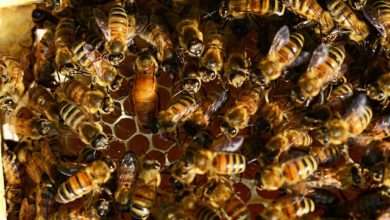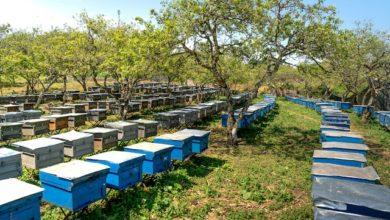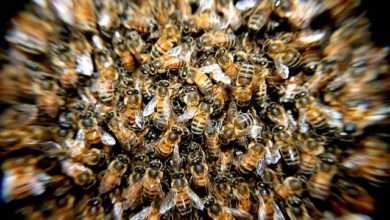What are Festooning Bees?
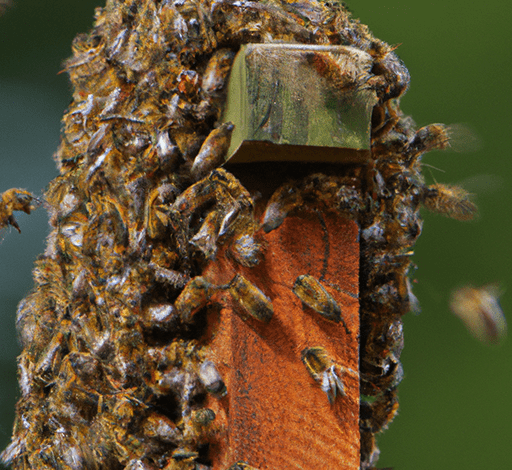
As we continue to learn about bees and their behavior, we come across various names and terms used to describe their daily activities. One such term is ‘festooning bees,’ which can be confusing for those who have never heard it before. However, once you understand what it means, you will realize the vital role that these tiny little creatures play in their colony’s life.
The Purpose and Benefits of Festooning
Bees festooning is an activity that can be observed in a beehive during the honey-making season. This process involves bees hanging together in clusters and attaching themselves to each other in chains or arcs. They use their wax-carrying glands to form a bridge that links one comb to another.
You may be wondering why bees engage in this activity. There are several reasons bees festoon, and they all contribute significantly to the colony’s survival and the production of honey.
1. Temperature control:
One of the primary reasons why bees festoon is to regulate the temperature inside the hive. By clustering together, bees can generate heat through their metabolic processes, which raises the temperature in the hive. Conversely, they can decrease the temperature by hanging outside the hive and fanning their wings to cool the hive.
2. Comb construction:
Another reason why bees festoon is to construct and maintain the comb. The bees will hang in chains and use their wax glands to construct the hexagonal-shaped cells of the comb. The bees will also use their bodies to mold the wax into the desired shape and size.
3. Honey production:

Bees festooning is also a vital part of honey production. When the colony needs more space to store honey, the bees will start building new combs. They will also use existing combs and fill up empty cells with honey. By festooning, they can link together several combs, creating one large honey storage space.
4. Defense mechanism:
Bees also use festooning as a defense mechanism. When bees detect a foreign object or predator near the hive, they will link together and start vibrating their bodies. This vibration creates a loud buzz, which serves as a warning for the intruder to stay away.
Definition of Festooning
Festooning behavior in bees refers to the linking of individual bees to form a chain-like structure using their mandibles and forelegs. The bees hang upside down from the ceiling of the hive and use their bodies to form a bridge, which other bees can use to move around the hive.
Explanation of Festooning
The primary reason for festooning behavior in bees is to construct the beeswax comb. The beeswax comb is the physical structure that bees use to store food and raise their young. The bees link together and form a bridge to create the comb, which can be several feet in length.
The bees that participate in festooning behavior are typically young bees, between 1-3 days old. These bees have a wax gland on their abdomen that they use to produce beeswax. When the bees link together, they secrete small amounts of beeswax from their wax glands, which they use to create the comb.
Festooning behavior is not limited to constructing the beeswax comb. Bees also use festooning to create a bridge over gaps in the comb or to link together when they swarm. When bees swarm, they leave their original hive in search of a new location. The bees link together in a chain formation to protect the queen bee and transport her to the new location.
The Role of Wax in the Festooning Process
Wax is the primary construction material used by bees to build comb, and it plays a crucial role in the festooning process. Bees produce wax from the special glands on their abdomens, which secrete a substance called “wax scales.” These scales are then manipulated by the bees using their mandibles until they become a soft, pliable material that can be shaped to form the honeycomb.
During the festooning process, bees produce more wax than they require to construct the comb. They use this excess wax to coat the chains of bees that form the scaffold, creating a smooth, waxy surface for the other bees to cling onto. This wax coating also helps to hold the bees in place, preventing them from slipping or falling while working on the comb.
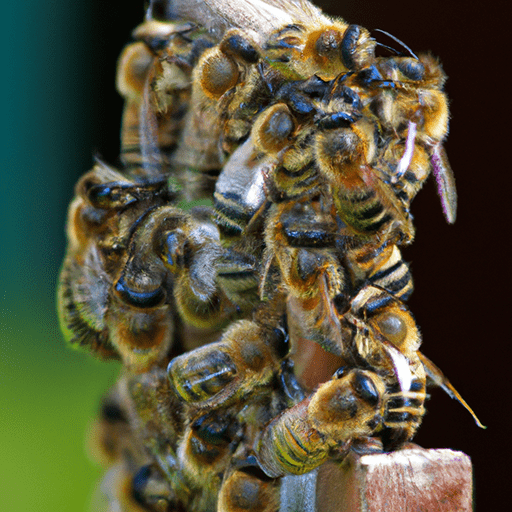
Wax production is not just limited to the construction of the honeycomb. Bees also use wax to form the entrance to their hive and to seal any gaps or cracks. The wax coating not only provides a waterproof barrier but also helps to maintain the temperature and humidity levels inside the hive.
Festooning and Communication
Festooning also facilitates communication among bees. Worker bees use scent cues called pheromones to communicate with each other, and a cluster of bees in a bridge or chain may act as a conduit for these signals. By filtering pheromones from one area of the hive to another, bees can coordinate their activities and work efficiently as a group.
Identifying Festooning Behavior
Festooning behavior is seen mainly during swarming, but it can also be observed during honey production. As a beekeeper, you can identify this behavior by observing how the bees interact with one another. During the honey season, bees will start to build comb, and you may notice several bees hanging together in loops or chains. In contrast, during swarming, the queen bee will be in the center of the chain, and the bees will form a sphere around her.
Encouraging Festooning Behavior
Festooning is a behavior that is essential for the survival of a colony. As a beekeeper, there are specific measures to take to encourage festooning behavior in your colonies. Here are some practical tips to encourage festooning in your bees.
- Encourage Brood Rearing: In the bees’ natural habitat, brood rearing season and the honey season occur simultaneously. However, beekeepers often manipulate the colony, causing the brood rearing season to coincide with honey production. This causes the bees to be busy tending to the brood, making it challenging to build the comb structure. To avoid this, try and ensure that there is a steady supply of pollen and nectar for the bees to collect.
- Create Ideal Conditions: Bees need a specific temperature and humidity to build the comb structure. As a beekeeper, it is your responsibility to ensure that your hives are well insulated, ventilated, and the temperature is stable.
- Give Them Space: As the bees build the comb, they require sufficient space to maneuver. Overcrowding can hinder their progress and lead to stress. Ensure that your hive has enough space to avoid such scenarios.
The Benefits of Festooning for Honey Production and Colony Health
As a beekeeper, it is essential to understand how festooning can positively impact honey production and colony health.
Here are some of the benefits of festooning and how it contributes to a healthy and productive bee colony:
- Increased Honey Production
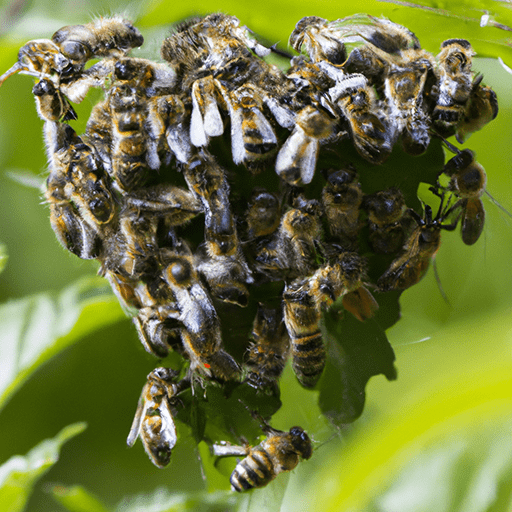
Festooning plays a crucial role in honey production. During the nectar flow, bees use their bodies to create an arch over the honeycomb, thereby allowing other bees to cluster and deposit the nectar. This action spreads the nectar evenly, which assists in reducing the moisture content, leading to faster honey ripening.
Moreover, the bees’ ability to control the wax temperature and manipulate comb shape enhances the honey production process. The heat generated in the comb during the clustering phase is used to keep the honey liquefied, which makes it more manageable for other bees to deposit nectar when they return from foraging.
- Improved Colony Health
Festooning promotes colony health as it helps regulate temperature and humidity levels within the hive. Bees use their bodies to form clustered chains that create a stable temperature inside the hive. This effective temperature regulation assists in maintaining the hive’s overall health by ensuring the brood rearing temperature is consistently around 34-35°C.
Additionally, festooning helps to control the overall humidity levels of a hive. Clustered bees generate heat, which reduces humidity by evaporating the excess moisture inside the hive. The reduced humidity levels are essential in preventing the growth of disease-causing organisms that thrive under damp conditions.
- Improved Queen Acceptance
Festooning promotes the acceptance of a new queen by creating a conducive environment for the hive’s overall state. The bees use their bodies to form a chain around the new queen, creating a tight cluster that keeps her warm and protected during the early stages of her acceptance.
The bees at the top of the cluster push heat downwards, and those at the bottom of the cluster push the warmth back up. This action ensures that the queen remains at an optimum temperature that encourages her to lay eggs, thus improving the colony’s productivity.
Potential Risks of Festooning
- Connection of Infected Hives: Festooning usually involves creating a bridge using strands of wax. However, this bridge can connect hives that are infected with diseases such as Nosema, Varroa, or Acute Bee Paralysis, which can spread diseases through the entire colony.
- Weak and Deteriorated Wax Strands: Wax strands that bees use for festooning can become weak and deteriorate over time. When this happens, bees can fall into other hives, which can potentially cause a fight between different colonies.
- Creation of Burcomb: Festooning can sometimes result in the creation of burcomb, which is a piece of comb that extends beyond the existing comb. Burcomb can make it difficult for beekeepers to inspect the hive, and it can also cause brood comb to break.
- Swarming: Festooning can also lead to the swarming of bees. When bees feel overcrowded in the hive and have no enough space to build or expand their colony, they may swarm to look for a new home.
Challenges of Festooning

- Time-consuming: Festooning requires a lot of effort, and it can be quite time-consuming. The bees need to build the wax strands to hang and connect to different frames to form a bridge-like structure, which can take a long time.
- Labor-intensive: Festooning can also be labor-intensive, particularly when you need to handle multiple hives. You need to check to ensure that the wax strands are strong and secure enough, which can be quite exhausting.
- Limited control: Beekeepers have limited control over festooning. They can only provide an environment that encourages the bees to festoon, but they have no way of controlling the bees’ behavior.
Conclusion
Festooning bees are an amazing team of dedicated workers that play a vital role in the health and productivity of a colony. Their use of wax to create unique web-like structures helps regulate temperature, prevent disease, and promote healthy honey production.
By knowing what to look for when identifying festooning behavior, beekeepers can gain valuable insight into the health and productivity of their colonies.
Whether you are a hobbyist or professional beekeeper, incorporating festooning behaviors into your colony management plan will provide a wealth of benefits that will help ensure the success of your bees for years to come.
So, get ready to experience the fascinating world of festooning bees and watch in amazement as they work their magic to create a thriving honeybee community!
